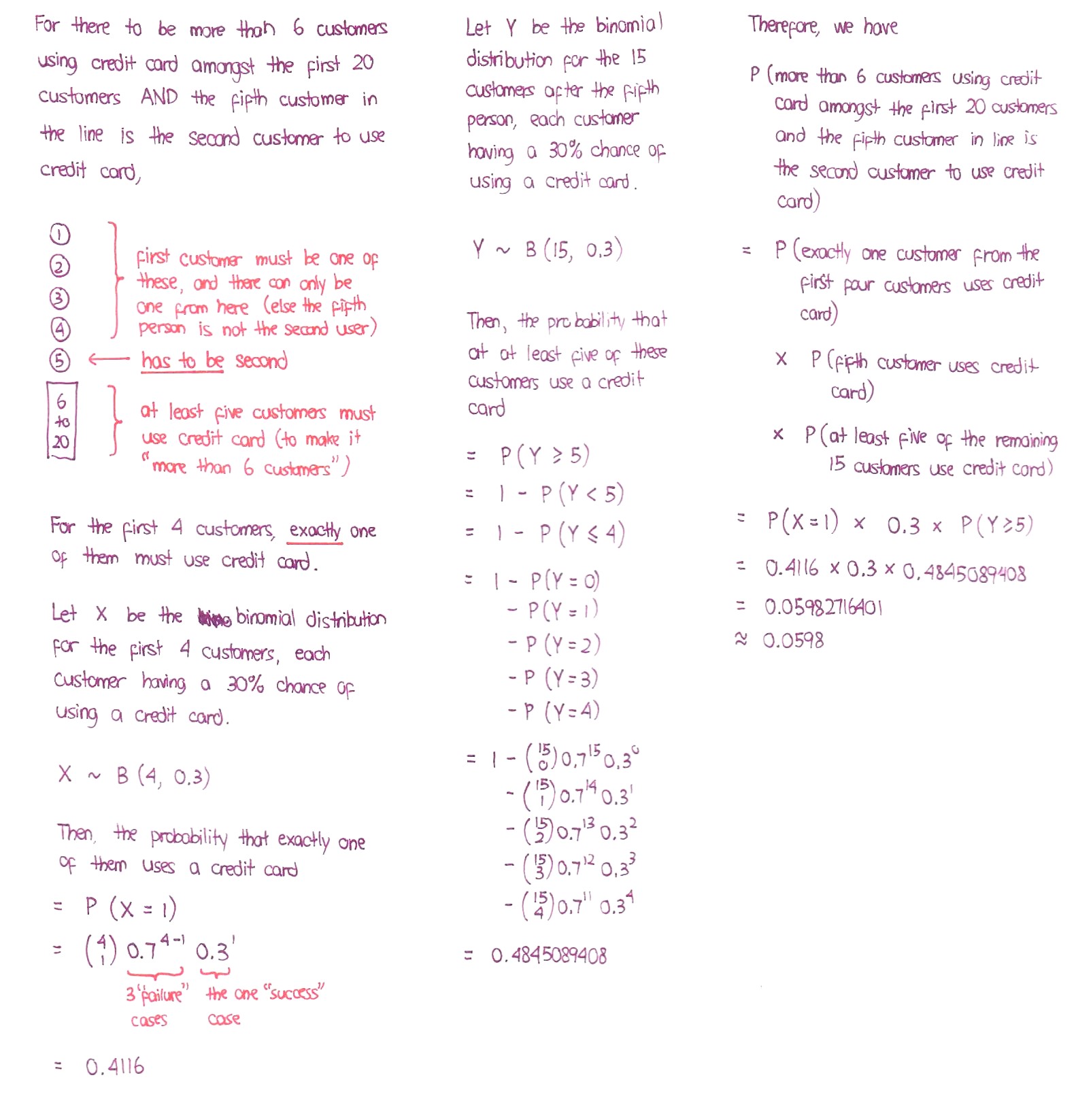Ask Singapore Homework?
Upload a photo of a Singapore homework and someone will email you the solution for free.

Question
junior college 2 | H2 Maths
One Answer Below
Anyone can contribute an answer, even non-tutors.

I need help for the last part when they say fifth customer is the second customer how do i use it in binomialcdf
Then X~B(20,0.3)
P(more than 6 customers who pay by card)
= 1 - P(6 or less customers who pay by card)
= 1 - P(X ≤ 6)
= 1 - 0.60801 (use binomcdf (20,0.3,6) )
= 0.39199
hold on for next part
P (as stated in the question)
= P (exactly one customer in the first 4 customers pay by credit card) * P (fifth person pays by credit card) * P (at least five more customers within the next 15 people pays by credit card)
(Updated)
P (more than 6 customers out of 20 pays by credit card).
I think there is no need for it though since my earlier probability already takes this into account.
So that's a minimum of 7 people who pay by card out of the 20 people.
If the 5th customer is the second to do so, then the first customer to do so must be among one of the first 4 customers.
Since we need a minimum of 7 to pay by card,
For the remaining 15 customers, there must be a minimum of 5 people who pay by card.
X ~ B (4, 0.3)
and if I let Y be a binomial distribution for the last 15 people,
Y ~ B (15, 0.3).
As J noted, to have more than six people in the list of 20 paying by credit card, the minimum number of customers paying by credit card in the first 20 customers must be seven.
The breakdown for this is
- exactly one out of the first four customers pay by credit card
- the fifth customer MUST pay by credit card (itself with a probability of 0.3)
- at least five of the next 15 customers pay by credit card
In short, our required probability
= P (X = 1) * 0.3 * P (Y >= 5)
We need to work out what P (X = 1) and P (Y >= 5) are equal to, before inputting our answers above.
P (Y >= 5) can be computed via 1 - P (Y <= 4).
I have no graphing calculator for this.
= P(X = 1) x 0.3 x (1 - P(Y ≤ 4) )
= 0.4116 (use binompdf(4,0.3, 1) ) x 0.3 x (1 - 0.51549) (use binomcdf(15,0.3, 4)
= 0.4116 x 0.3 x 0.48451
= 0.0598272948
= 0.0598 (3 s.f)
X ∼ B(20,0.3)
There are 4 ways for the 1st card-using customer to be among the first 4 customers and the 2nd card-using customer to be the 5th customer :
First Second Third Fourth Fifth
Card / Cash / Cash / Cash / Card
Cash / Card / Cash / Cash / Card
Cash / Cash / Card / Cash / Card
Cash / Cash / Cash / Card / Card
That is 4 ways out of the total number of ways for each case for the first 5 people.
Now for the case X = 7, we pick 7 out of 20 to be card paying. 2 of them are among the first 5.
Then for the other 15 card paying customers, there is no restriction so we just choose 5 out of the remaining 15.
So number of ways = 4 x 15C5
For the case of X = 8, we pick 8 out of 20.
Number of ways = 4 x 15C6
So on and so forth for X = 9 all the way to X = 17
(We cannot consider X = 18, X = 19, X = 20 as that would mean the 5th customer can never be the second to do so)
Required probability
= P(X = 7) x 4(15C5)/(20C7)
+ P(X = 8) x 4(15C6)/(20C8)
+ P(X = 9) x 4(15C7)/(20C9)
+ P(X = 10) x 4(15C8)/(20C10)
+ P(X = 11) x 4(15C9)/(20C11)
+ P(X = 12) x 4(15C10)/(20C12)
+ P(X = 13) x 4(15C11)/(20C13)
+ P(X = 14) x 4(15C12)/(20C14)
+ P(X = 15) x 4(15C13)/(20C15)
+ P(X = 16) x 4(15C14)/(20C16)
+ P(X = 17) x 4(15C15)/(20C17)
= 0.0598 (3 s.f)
As per the formula for the binomial pdf,
P(X = 7) x 4(15C5)/(20C7)
= (20C7) x 0.3^7 x 0.7^13 x 4(15C5)/(20C7)
= 0.3^7 x 0.7^13 x (4C1)(15C5)
= (4C1)(0.3 x 0.7³) x 0.3 x (15C5)(0.3^5 x 0.7^10)
And this is actually equal to P(X=1) x 0.3 x P(Y=5) as shown in Eric's method of splitting up into 2 distributions.
Likewise,
P(X = 8) x 4(15C6)/(20C8)
= (20C8) x 0.3^8 x 0.7^12 x 4(15C6)/(20C8)
= 0.3^8 x 0.7^12 x (4C1)(15C6)
= (4C1)(0.3 x 0.7³) x 0.3 x (15C6)(0.3^6 x 0.7^9)
= P(X=1) x 0.3 x P(Y=6)
So the total probability
= P(X = 1) x 0.3 x [ P(Y = 5) + P(Y=6) + ... + P(Y = 15) ]
= P(X = 1) x 0.3 x P(Y ≥ 5)
See 1 Answer
All it does is to consolidate all the individual calculations to save the user the hassle of manual keying.
The student should get the same mark this question is done is the normal probability way
I myself do not have a gc (my JC one malfunctioned years ago), so I had no choice but to do these manually.
The GC's limitation is that it cannot calculate P(X ≥n) directly (at least for TI), yet these sites can. Not worth the $100+ price tag





